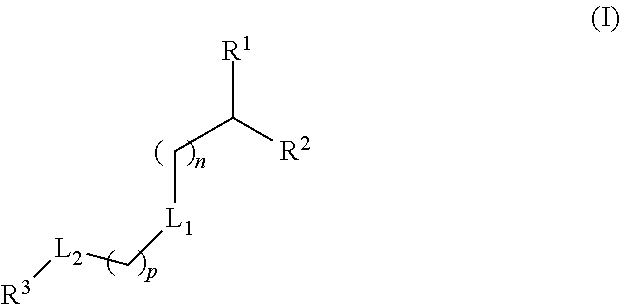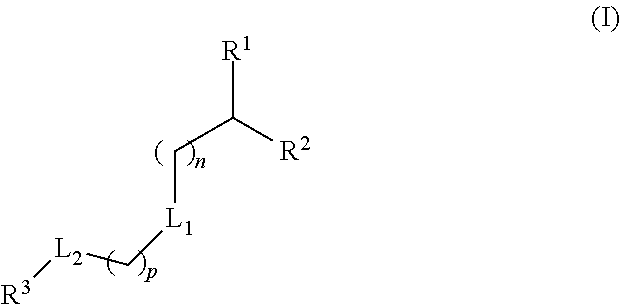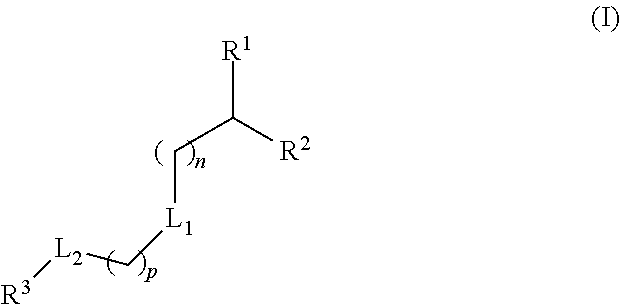Lipids and Lipid Compositions for the Delivery of Active Agents
a technology of active agents and lipids, applied in the direction of viruses, microcapsules, dna/rna fragmentation, etc., can solve the problems of increasing the risk of toxic effects and side effects, hindering the delivery of biologically active agents to subjects, and reducing the therapeutic index of the drug, so as to improve the therapeutic index, and improve the effect of efficacy
- Summary
- Abstract
- Description
- Claims
- Application Information
AI Technical Summary
Benefits of technology
Problems solved by technology
Method used
Image
Examples
example 1
Synthesis of 2-(10-dodecyl-3-ethyl-8,14-dioxo-7,9,13-trioxa-3-azaoctadecan-18-yl)propane-1,3-diyl dioctanoate
[0727]
[0728]In a round bottom flask, Intermediate 1f (1.99 g, 4.66 mmol), DMAP (0.207 g, 1.693 mmol), DIPEA (1.48 mL, 8.47 mmol), and Intermediate 1k (1.7 g, 13.07 mmol) were taken into dichloromethane (20 mL). EDC.HCl (1.62 g, 8.47 mmol) was added in one portion, and the reaction was stirred at ambient temperature. After 24 h, the reaction was concentrated under reduced pressure. The residue was purified by silica gel column chromatography (0% to 5% MeOH in CH2Cl2). Fractions were collected and solvents were removed under reduced pressure to provide a yellow oil (3.8 g). The oil was repurified by silica gel column chromatography (0-75% EtOAc / heptane) to afford the title compound as an off-white oil (2.6 g, 71.8%). 1H NMR (400 MHz, CDCl3) δ=4.80 (t, J=6.1 Hz, 1H), 4.25-3.96 (m, 8H), 2.62 (br. s., 4H), 2.30 (t, J=7.5 Hz, 6H), 2.05-1.85 (m, 5H), 1.71-1.53 (m, 8H), 1.43-1.21 (m,...
example 2
2-(9-dodecyl-2-methyl-7,13-dioxo-6,8,12-trioxa-2-azaheptadecan-17-yl)propane-1,3-diyl dioctanoate
[0730]
[0731]1H NMR (400 MHz, CDCl3) δ=4.80 (t, J=5.4 Hz, 1H), 4.28-3.98 (m, 8H), 2.65-2.35 (m, 8H), 2.30 (t, J=7.5 Hz, 6H), 2.09-1.84 (m, 5H), 1.74-1.50 (m, 8H), 1.48-1.33 (m, 8H), 1.33-1.18 (m, 32H), 0.88 (t, J=6.8 Hz, 9H). 13C NMR (101 MHz, CDCl3) δ=173.47 (2C), 173.06, 154.53, 75.34, 63.55 (3C), 60.18, 55.48, 44.41 (2C), 36.90, 33.95 (2C), 33.91, 33.68, 32.70, 31.59, 31.34 (2C), 29.33 (2C), 29.31, 29.24, 29.17, 29.12, 29.02, 28.79 (2C), 28.59 (2C), 27.61, 26.02 (2C), 24.73, 24.64 (3C), 22.36, 22.26 (2C), 13.78, 13.73 (2C).
example 3
2-(9-dodecyl-2-methyl-7,13-dioxo-6,8,12-trioxa-2-azapentadecan-15-yl)propane-1,3-diyl dioctanoate
[0732]
[0733]1H NMR (400 MHz, CDCl3) δ=4.88-4.71 (m, 1H), 4.28-3.98 (m, 8H), 2.54 (br. s., 2H), 2.48-2.35 (m, 6H), 2.31 (t, J=7.7 Hz, 6H), 2.13-1.98 (m, 2H), 1.98-1.85 (m, 3H), 1.71 (q, J=7.5 Hz, 2H), 1.65-1.49 (m, 6H), 1.40-1.16 (m, 36H), 0.97-0.80 (m, 9H). 13C NMR (101 MHz, CDCl3) δ=173.69 (2C), 172.89, 154.84, 75.60, 63.55 (3C), 60.72, 55.77, 45.05-44.29 (2C), 36.80, 34.24, 34.20 (2C), 33.00, 31.90, 31.64 (2C), 31.42, 29.65, 29.63 (2C), 29.56, 29.49, 29.44, 29.33, 29.09 (2C), 28.90 (2C), 25.06, 24.91 (3C), 23.44, 22.66, 22.58 (2C), 14.10, 14.04 (2C).
PUM
| Property | Measurement | Unit |
|---|---|---|
| Immunogenicity | aaaaa | aaaaa |
Abstract
Description
Claims
Application Information
 Login to View More
Login to View More - R&D
- Intellectual Property
- Life Sciences
- Materials
- Tech Scout
- Unparalleled Data Quality
- Higher Quality Content
- 60% Fewer Hallucinations
Browse by: Latest US Patents, China's latest patents, Technical Efficacy Thesaurus, Application Domain, Technology Topic, Popular Technical Reports.
© 2025 PatSnap. All rights reserved.Legal|Privacy policy|Modern Slavery Act Transparency Statement|Sitemap|About US| Contact US: help@patsnap.com



